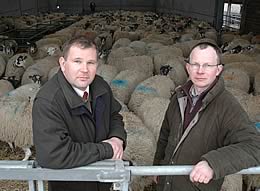 |
|||||||||
|
|||||||||||||||||||
Economies of scale
for North Sheep 2005 farm
| |||||||||||||||||||
 |
North Sheep 2005, the NSA Northern region's biennial event is to be staged on Wednesday 1 June by kind permission of Cumbrian agri-businessman Allan Jenkinson, on his Whinfell Park estate, near Penrith, where sheep are the core ingredient.
Maintaining the sheep enterprise within the top third of costed flocks and achieving even greater economies of scale are the ways forward at Whinfell Park, according to its estate manager, Nick Scholefield.
“Our 3,200 ewe flock of Mules and Texel cross Mules is without doubt the current most profitable enterprise on this unit. In 2004, we sold in the region of 5,700 head of finished lamb through the ring to average £52. We use Texel and Beltex rams to produce high quality crosses to match market requirements and we believe demand will remain buoyant for such lamb for the foreseeable future,” he explains.
“Given the opportunity we plan to expand the estate enabling us to increase the flock and allocate one shepherd per 2,000 ewes. During the past 20 years, the unit has expanded ten fold to its current 1,700 acres, along with the volume of stock carried.”
Sheep are the vital ingredient at Whinfell Park, a mixed lowland unit lying on sandstone in the Eden Valley which also carries a newly established 150 cow pedigree Limousin herd. “We've 1,000 acres down to permanent pasture and grass leys and the remainder to wheat, barley and oilseed rape, and it's that mix of corn and horn that enables us to operate a successful rotation.”
The unit's farm manager, Iain Scott has established a simple, relatively high input high output sheep enterprise. Lambing commences on 1 March, the Mules average 200% lambs reared and Texel cross ewes, 175% lambs reared. Within 14 weeks, lambs reach the target 45kg liveweight ready for the first draw.
“We achieve a regular income by marketing an average 200 lambs per week throughout the season commencing with the Texel cross Mules, while the slower maturing three quarter bred Texels hit the higher quality lamb market later on,” he explains. The entire crop is sold finished apart from a portion of Texel cross gimmers retained for replacement purposes and supplemented with shearling Mules bought in from Lazonby.
“We find it cost effective to creep the lambs during their last two weeks at grass to introduce that extra finish which ultimately commands a premium,” he says adding: “We're great believers in supporting the live auction because it puts a real bottom in the marketplace, and it also provides us with a show case. Our lambs are traded to repeat buyers who work with both high street retail outlets and multiples.”
Whinfell Park's impressive array of accommodation which doubles up for storage purposes, plus five sets of permanent handling pens strategically located over the four mile long estate facilitate the sheep enterprise's smooth running by shepherds, Andrew Howe and Alan Law. They are assisted by up to seven casuals during the busiest two weeks of lambing.
“Immediately after scanning, 1,000 ewes are housed including all those carrying triplets and a portion with twins, and the remainder, one week prior to lambing,” Iain explains. “Housing makes for easier management including feeding a uniform least cost TMR diet based on home grown barley and grass silage,” he says.
“Equally important to us handling comfortably such large volumes of sheep are the outlying handling pens. We're able to stage five separate gathers close to where the sheep are grazing and we can for example take the mobile shower to them. We use contract shearers, otherwise we carry out all the routine work ourselves. We worm the ewes twice during the grazing season, and last year dung sampling the lambs helped us determine worm thresholds and subsequently halve the number of treatments.”
Post FMD, the estate's beef enterprise had intended to change direction from buying in store cattle for finishing purposes to establishing a closed suckler herd. However those plans were overtaken by ambitions to introduce a pedigree beef herd and 2002 heralded the introduction of the first pedigree Limousins. Nick says numbers have rapidly grown to 150 cows, including 50 French imported breeding females, and the herd's next five year goal is for it to be within the breed's top 10%.
He adds: “As far as our sheep enterprise is concerned, we plan to keep a keen eye on the commercial marketplace for finished lamb. According to EBLEX, all the evidence indicates that breeding sheep numbers continue to remain stable, therefore I can't foresee any radical changes in the short to medium term. However we are ready to react as and when necessary to match any emerging new requirements in order to maintain the enterprise's current profitability.”

| property | organisations | site map
